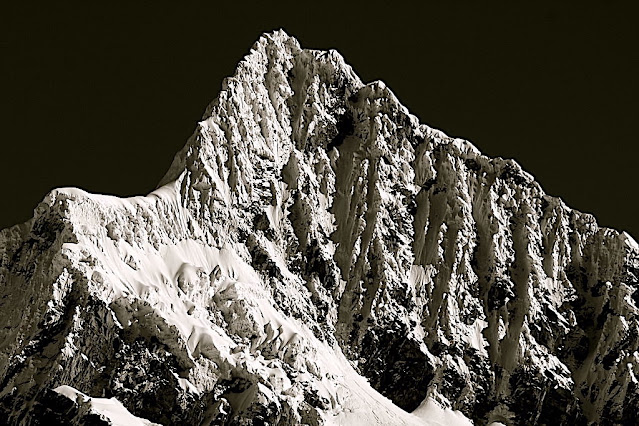In "Alpamayo summit", argentic photo 1936
The mountain
Alpamayo ( 5,947m - 19,511 ft) possibly named from Quechua words is one of the
most conspicuous peaks in the Cordillera Blanca of the Peruvian Andes.
Alpamayo Creek originates northwest of it. The Alpamayo lies next to the
slightly higher Quitaraju. n July 1966, the German magazine
"Alpinismus", published a photo of Alpamayo taken by American
photographer Leigh Ortenburger accompanied by an article on a survey
among mountaineering experts, who chose Alpamayo as "The Most Beautiful
Mountain in the World". Not defined by a single summit Alpamayo has two
sharp summits, the North and south, which are separated by a narrow
corniced ridge.
The first attempt on Alpamayo's summit was in 1948
by a Swiss expedition. Climbing by way of the heavily corniced North
Ridge, the three climbers came within sight of the virgin summit when a
large cornice broke under them and they were carried down the
precipitous Northwest Face. By some amazing piece of good fortune, the
three were neither buried nor injured by the 650 foot fall and they were
able to make an 'orderly retreat' from the mountain. In 1951, a
Franco-Belgian expedition including George and Claude Kogan claimed to
have made the first ascent via the North Ridge. After studying the
photos in George Kogan's book The Ascent of Alpamayo, the German team of
Günter Hauser, Frieder Knauss, Bernhard Huhn and Horst Wiedmann came to
the conclusion that the 1951 team did not reach the actual summit,
thereby making their ascent via the South Ridge in 1957 the first.
Although the South Ridge is no less steep or dangerous than the North
Ridge, it has the advantage of leading directly to the higher south
summit. This was written up in Hauser's book White Mountain and Tawny
Plain. Although there are several climbing routes on the Southwest Face
the most common is known as the Ferrari or Italian Route. It was opened
in 1975 by a group of Italian alpinists led by Casimiro Ferrari. It
begins at the top of the highest point of the snow slope where the
bergshrund separates the upper face on the left and then ascends a steep
runnel to the summit ridge. Because of its esthetic beauty, Alpamayo is
one of the most climbed mountains in the Andes and the base camp can be
a hodge-podge of nationalities. Each year the route is made easy by the
first party to ascend the route as they usually leave snow-stakes in
place at the belay stations. Then it is just a matter of finding out
what length of rope they used so that your rope is long enough to reach
each station. In the summer of 1988, they had used 50m ropes.
The photographer
Erwin
Hermann Manfred Schneider was an Austrian mountaineer. On July 25,
1928, he was part of the German-Soviet expedition for the first ascent
of Lenin Peak. They reach the top with Karl Wien and Eugen Allwein. In
1930, he participated in an expedition in the Himalayas led by Günter
Dyhrenfurth to Kangchenjunga. On June 21, 1931, he made the first ascent
of Jongsong Peak at 7,462 meters1,2. They climb the Ramthang Chang at
6,802 meters. In 1932 and 1936, he took part in two expeditions
organized by the German-Austrian Alpine Club (DuOeAV). During these
expeditions, Schneider and his companions made about ten first ascents.
2022 - Wandering Vertexes...
by Francis Rousseau




